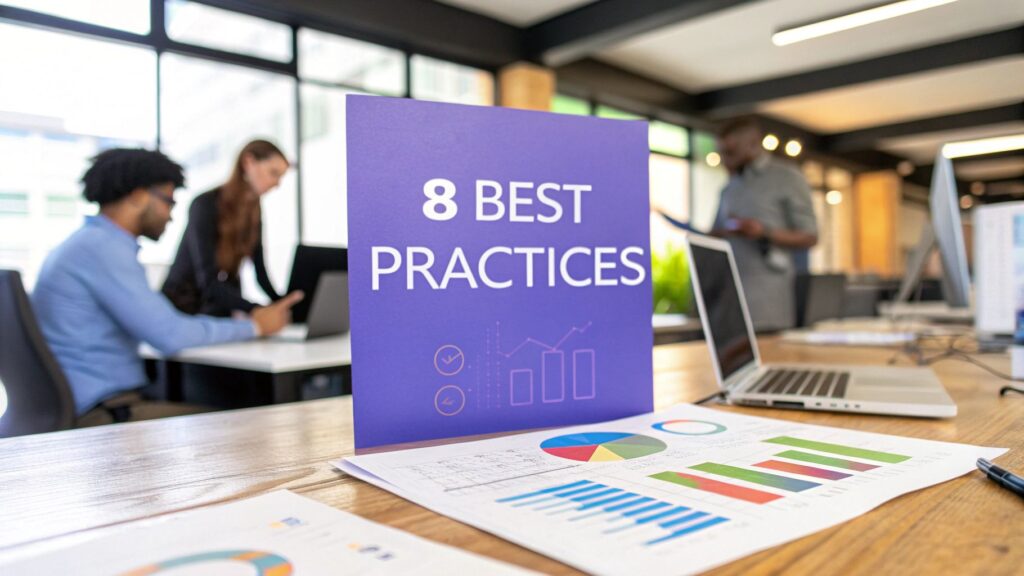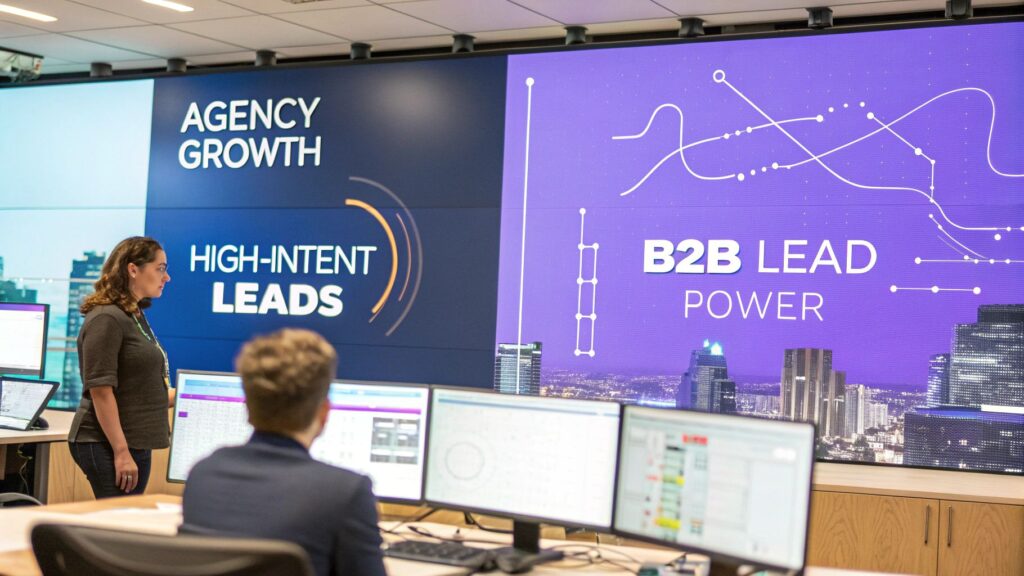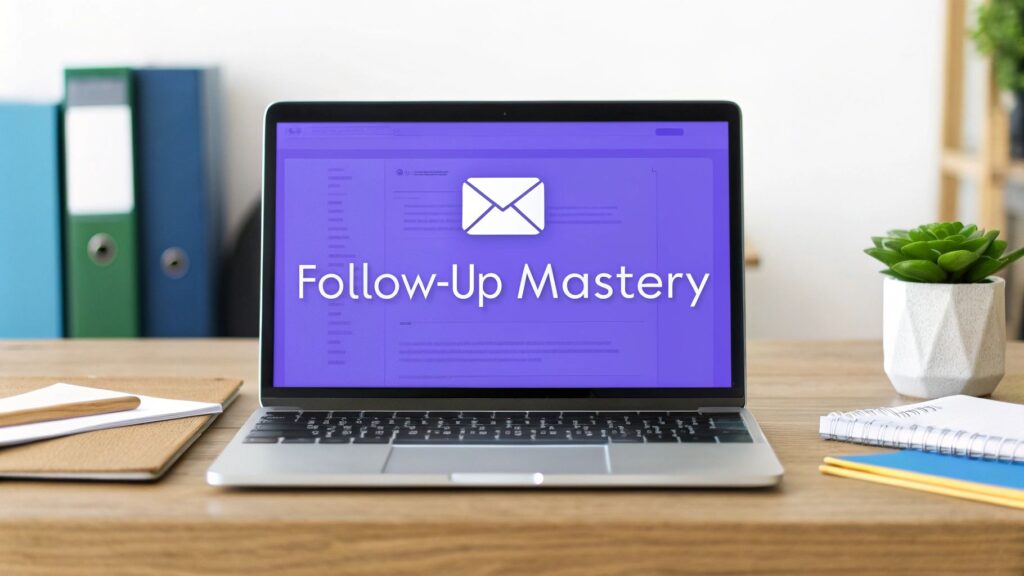8 Business Development Best Practices for Agencies in 2025

- 1. Strategic Relationship Mapping
- 2. Value-Based Selling Framework
- 3. Account-Based Development (ABD)
- 4. Continuous Market Intelligence and Competitive Analysis
- 5. Multi-Stakeholder Engagement Strategy
- 6. Partnership and Channel Development
- 7. Customer Success-Driven Expansion
- 8. Data-Driven Lead Qualification and Scoring
- Best Practices Comparison Matrix
- Putting These Practices Into Action for Sustainable Growth
In today's competitive agency landscape, relying on outdated lead generation tactics is a recipe for stagnation. The spray-and-pray approach is dead, and generic outreach no longer cuts through the noise. To secure high-value clients and drive sustainable growth, your team needs a sophisticated, data-driven strategy built on proven business development best practices.
This guide moves beyond surface-level advice to provide a detailed roundup of eight actionable frameworks. We will explore advanced strategies designed for modern agencies, from strategic relationship mapping and value-based selling to account-based development and multi-stakeholder engagement. Each practice is broken down with specific implementation details, practical examples, and factual data to help you build a powerful and repeatable client acquisition engine.
You will learn how to identify and connect with key decision-makers, create compelling value propositions, and leverage partnerships for exponential growth. We'll also highlight how to use timely data, such as recent funding announcements, to gain a critical edge. This approach ensures you connect with high-intent prospects at the perfect moment, turning your business development efforts from a numbers game into a strategic advantage that consistently delivers results.
1. Strategic Relationship Mapping
Effective business development moves beyond simple contact lists. One of the most impactful business development best practices is Strategic Relationship Mapping, a systematic approach to visualizing and understanding the complex web of connections within a target organization. Instead of just knowing who's who, this method helps you understand who influences whom, who holds decision-making power, and where your strongest allies are. A study by the CEB (now part of Gartner) found that the average B2B buying group involves 6.8 decision-makers, making this mapping essential.
This practice involves creating a visual chart of stakeholders, decision-makers, influencers, and potential partners. For example, a global consulting firm like McKinsey & Company often maps a client’s entire organizational structure before a major engagement to identify key sponsors and potential blockers. This allows their teams to navigate internal politics and build consensus more effectively, ensuring smoother project execution and stronger client relationships.
How to Implement Strategic Relationship Mapping
To get started, focus on your most critical accounts. Identify every individual involved in the decision-making process, from the end-user to the C-suite executive. Then, plot them on a map, connecting them based on formal reporting structures and, crucially, informal influence.
Actionable steps include:
- Start Small: Begin with one or two high-value prospects or key accounts to refine your process.
- Use Visualization Tools: For complex accounts, leverage platforms like Kumu or Lucidchart to create dynamic and shareable maps.
- Document Everything: Update your map after every significant interaction, organizational change, or new piece of intel gathered from platforms like LinkedIn.
- Identify Key Roles: Categorize contacts as Champions (advocates for your agency), Blockers (obstacles to the deal), Influencers (sway opinions), and Decision-Makers (hold the final say).
The following concept map illustrates the core concepts that define a stakeholder's role within your relationship map.
This visualization highlights how a stakeholder's true importance is a combination of their formal power, their ability to influence others, and how frequently you engage with them. By mapping these attributes, your agency can prioritize its efforts, directing resources toward building relationships with individuals who have both high influence and significant decision-making authority.
2. Value-Based Selling Framework
Shifting away from a product-feature or price-led discussion, the Value-Based Selling Framework is a sales methodology that centers the conversation on the tangible, quantifiable business value a solution delivers. This essential business development best practice requires you to connect your agency's services directly to a prospect's key business objectives, such as increasing revenue, reducing operational costs, or mitigating risks. Research from McKinsey shows that companies excelling at value-based selling have 5-10% higher revenue growth than their peers.
For instance, a technology giant like Oracle doesn't just sell enterprise software; it demonstrates the specific productivity gains and cost savings its systems provide. Similarly, a firm like Palantir quantifies the value of its platform by highlighting improvements in decision-making speed and risk reduction for its clients. This approach frames the investment not as a cost, but as a direct driver of measurable ROI, justifying a premium price and building a stronger business case.
How to Implement a Value-Based Selling Framework
To successfully adopt this framework, your team must deeply understand your clients' financial and operational drivers. It begins with asking better questions to uncover the core business problems and then translating your services into a compelling financial narrative.
Actionable steps include:
- Develop Industry-Specific Frameworks: Create tailored value propositions and case studies for each vertical you serve. A B2B SaaS client cares about different metrics (e.g., churn reduction) than a CPG brand (e.g., market share growth).
- Create Interactive ROI Calculators: Build simple online tools that allow prospects to input their own data (e.g., current conversion rate, team size) and see potential financial returns, making the value proposition tangible and personalized.
- Train Teams on Business Acumen: Equip your business development professionals with the skills to understand financial statements, conduct business case analysis, and speak the language of the C-suite.
- Quantify Customer Success: Collect and meticulously document customer success stories, focusing on hard numbers. Highlight metrics like "reduced customer acquisition cost by 30%" or "increased lead-to-close ratio by 15%."
3. Account-Based Development (ABD)
Moving away from a wide-net approach, Account-Based Development (ABD) is a highly focused strategy where marketing and sales teams collaborate to turn a specific set of high-value accounts into clients. This is one of the most effective business development best practices because it treats each target account as a "market of one," allowing for deeply personalized and coordinated engagement. According to ITSMA, 87% of marketers measuring ROI say that ABD outperforms other marketing investments.
The power of this method lies in its precision. For instance, a data warehousing company like Snowflake doesn't just market to the tech industry; it executes targeted ABD campaigns aimed at Fortune 500 companies with massive data needs. By aligning sales and marketing resources, they can engage multiple decision-makers within these enterprise accounts, from the CTO to data science leads, with tailored content that addresses their unique challenges and goals.
How to Implement Account-Based Development
To begin, you must shift from a volume-based mindset to a value-based one, concentrating your efforts on accounts that offer the highest potential return. This requires tight alignment between all customer-facing teams to ensure a seamless and consistent experience for the prospect. To learn more about the core principles behind this approach, you can read about what is account-based marketing.
Actionable steps include:
- Define Your Ideal Account Profile (IAP): Use firmographic (e.g., company size, industry), technographic (e.g., current software stack), and intent data to select a shortlist of accounts that perfectly match your best customers.
- Create Account-Specific Plays: Develop personalized content (e.g., a whitepaper addressing a target's specific competitor), custom-tailored outreach sequences, and unique value propositions for each target account.
- Coordinate Cross-Functional Teams: Ensure your sales, marketing, and customer success teams are working from the same playbook, sharing insights and coordinating actions in a weekly huddle.
- Measure Account-Level Metrics: Track engagement, pipeline velocity, and deal size for your target accounts instead of focusing on traditional metrics like lead volume.
4. Continuous Market Intelligence and Competitive Analysis
Static business development plans quickly become obsolete in a fast-paced market. One of the most critical business development best practices is embracing Continuous Market Intelligence and Competitive Analysis, the ongoing process of gathering, analyzing, and acting upon information about market trends, competitor movements, and customer needs. A report by Crayon found that 90% of businesses agree their industry has become more competitive in the last three years, making this practice non-negotiable.
This proactive approach involves systematically monitoring the competitive landscape to inform real-time decision-making. For instance, Microsoft’s dedicated competitive intelligence program constantly tracks developments in the cloud market, allowing them to rapidly adjust their Azure offerings and sales strategies in response to moves from Amazon Web Services or Google Cloud. This continuous loop of information gathering and strategic adaptation is key to maintaining a competitive edge.
How to Implement Continuous Market Intelligence
To begin, define what information will have the most significant impact on your agency’s growth. At the heart of this practice is a clear understanding of what competitive intelligence is: turning raw data into actionable insights that guide strategic choices.
Actionable steps include:
- Use Automated Tools: Implement platforms like Brandwatch, Semrush, or Crayon to automate the collection of data on competitor messaging, pricing changes, and customer reviews.
- Establish Feedback Loops: Create a formal process for your sales and account management teams to report insights from the field—such as a competitor's new sales pitch—back to leadership via a dedicated Slack channel or CRM field.
- Focus on Actionable Intelligence: Don’t just collect data. Analyze it to answer specific questions like, "Which new services are our competitors launching?" or "What customer pain points are they failing to address?"
- Create Regular Briefings: Schedule weekly or bi-weekly intelligence briefings for key decision-makers to ensure insights are consistently integrated into your business development strategy.
5. Multi-Stakeholder Engagement Strategy
Modern B2B buying decisions are rarely made by a single individual. An essential business development best practice is adopting a Multi-Stakeholder Engagement Strategy, which acknowledges that purchasing decisions involve a committee of people with diverse priorities and concerns. Data from Forrester confirms that 63% of B2B purchases involve more than four people.
This strategy moves beyond a single point of contact to build consensus across departments. For instance, HubSpot successfully engages marketing, sales, and IT stakeholders by tailoring its value proposition to each group's unique needs. This ensures that their platform addresses the specific pain points and objectives of everyone involved, from the CMO focused on ROI to the IT director concerned with integration and security.
How to Implement a Multi-Stakeholder Engagement Strategy
To effectively implement this strategy, you must first map the buying committee and understand each member's role and motivations. Instead of a one-size-fits-all pitch, create tailored messaging that resonates with the specific goals of each stakeholder, from financial to technical.
Actionable steps include:
- Create Stakeholder Personas: Develop detailed profiles for key roles, outlining their specific pain points, responsibilities, and success criteria. For a CFO, the criteria might be "clear ROI within 12 months," while for a CTO it might be "seamless API integration."
- Develop Role-Specific Content: Craft case studies, demos, and presentations that speak directly to the challenges and objectives of different departments like marketing, finance, or IT.
- Facilitate Alignment Meetings: Proactively bring different stakeholders together to discuss their needs and demonstrate how your solution creates unified value.
- Leverage Internal Champions: Identify and empower your advocates within the organization to help you navigate internal dynamics and influence their peers.
By engaging multiple stakeholders, your agency can de-risk the deal, accelerate the sales cycle, and build a broader, more resilient foundation for a long-term partnership. This approach ensures that your solution is not just bought but is also widely adopted and valued across the client's organization.
6. Partnership and Channel Development
Growth doesn't always have to come from direct client acquisition. A powerful business development best practice is building a strategic ecosystem of partners, which allows an agency to extend its reach and capabilities far beyond its internal resources. This involves creating alliances, referral programs, and technology integrations that drive mutual growth and create new revenue streams. According to a study by Forrester Consulting, companies with mature partnership programs grow revenue nearly 2x faster than companies with less mature programs.
This practice focuses on leveraging the networks and expertise of other organizations. For example, the Salesforce AppExchange provides a clear model of this success; thousands of independent software vendors build solutions on the Salesforce platform, creating a robust ecosystem where Salesforce gains enhanced functionality and partners gain access to a massive customer base. Similarly, the AWS Partner Network enables solution providers to build, market, and sell their offerings on AWS, accelerating innovation for all parties involved.
How to Implement Partnership and Channel Development
Start by identifying potential partners whose services complement your own without directly competing. A web design agency, for instance, could partner with a content marketing firm or an SEO specialist. The goal is to create a symbiotic relationship where you can refer clients to each other and collaborate on larger, integrated projects.
Actionable steps include:
- Define Partner Tiers: Categorize partners based on their level of engagement, such as referral partners (simple lead sharing), co-marketing partners (joint webinars/content), or technology integration partners (connected products).
- Invest in Enablement: Provide partners with the training, marketing materials, and dedicated support they need to successfully represent and sell your services. This could be a partner-exclusive portal with sales kits and resources.
- Establish Mutual Metrics: Create clear, shared goals and KPIs. Track referral volume, joint win rates, and co-marketing ROI, and hold regular quarterly business reviews (QBRs) to ensure alignment.
- Develop Joint Offerings: Collaborate to create bundled services or integrated solutions that offer unique value to clients, making the partnership more compelling than your individual offerings.
7. Customer Success-Driven Expansion
One of the most sustainable business development best practices is looking inward at your existing client base for growth. Customer Success-Driven Expansion is a strategy that focuses on generating new revenue from current, happy customers through upselling, cross-selling, and referrals. Bain & Company reports that increasing customer retention by just 5% can boost profits by 25% to 95%.
This approach is exemplified by companies like Shopify, which continuously adds new services like Shopify Capital and Shopify Payments for its existing merchant base. By focusing on helping their customers succeed, they create natural opportunities to expand their own service footprint. This method is far more cost-effective than acquiring new customers, as it leverages established trust and proven value. This focus on maximizing existing relationships also significantly improves your customer acquisition cost calculation by increasing lifetime value.
How to Implement Customer Success-Driven Expansion
To begin, your agency must align its business development and customer success teams. The goal is to identify expansion opportunities based on the value your agency is already delivering. Beyond initial sales, fostering enduring client relationships through robust customer success is vital for ongoing growth. To effectively measure and enhance these efforts, explore key customer success metrics that drive growth and expansion.
Actionable steps include:
- Conduct Regular Business Reviews: Schedule quarterly meetings with key accounts to review performance, showcase ROI, and proactively discuss their future business goals and challenges.
- Track Usage and Success Metrics: Monitor how clients use your services and the results they achieve. High engagement or specific achievements (e.g., a 200% increase in leads generated) are strong indicators for potential upsells.
- Create Expansion Playbooks: Develop standardized processes for identifying and acting on expansion opportunities. Define triggers, such as a client hitting a certain growth milestone, that prompt an upsell conversation.
- Foster Internal Collaboration: Ensure your business development team works closely with customer success managers to understand client health, satisfaction, and emerging needs.
8. Data-Driven Lead Qualification and Scoring
Not all leads are created equal, and pursuing every opportunity drains valuable resources. A cornerstone of modern business development best practices is Data-Driven Lead Qualification and Scoring, a systematic method for evaluating and prioritizing leads based on objective, measurable criteria. Research by Aberdeen Group shows that companies using lead scoring see a 77% greater lead generation ROI than companies that don't.
This practice involves assigning points to leads based on their demographic, firmographic, and behavioral data. For example, marketing automation leader HubSpot scores leads based on a contact’s job title, company size, and specific actions taken, like downloading an ebook or visiting the pricing page. This allows their sales team to instantly identify highly engaged, high-fit prospects and prioritize them for immediate follow-up, dramatically increasing efficiency and conversion rates.
How to Implement Data-Driven Lead Qualification and Scoring
To build an effective scoring model, you need to define what an ideal customer looks like for your agency and what actions signal genuine buying intent. This involves a close collaboration between your business development and marketing teams to align on criteria that predict success.
Actionable steps include:
- Combine Data Points: Build a comprehensive profile by using a mix of explicit data (company size, industry, role) and implicit behavioral data (website visits, content downloads, email engagement). For example, a VP of Marketing from a 500-person tech company gets +20 points, while visiting the pricing page adds another +10.
- Integrate with Your CRM: Ensure your lead scoring system is fully integrated with your CRM to provide real-time scores and trigger automated workflows, like assigning leads over a certain threshold directly to a BDR.
- Regularly Refine Criteria: Analyze your win-loss data quarterly. If leads with high scores are not converting, adjust your scoring model to better reflect what truly indicates a quality prospect.
- Train Your Team: Equip your business development representatives to understand what the scores mean and how to tailor their outreach based on a lead’s specific score and behavior.
By implementing this practice, you can transform your pipeline from a list of contacts into a prioritized roadmap of your most valuable opportunities. For a deeper dive into streamlining your sales efforts and ensuring high-quality leads, explore these automated lead qualification strategies. Pairing this with the right technology is also critical; you can learn more about lead generation automation tools on fundediq.co to build a more efficient system.
Best Practices Comparison Matrix
| Methodology | Implementation Complexity 🔄 | Resource Requirements ⚡ | Expected Outcomes 📊 | Ideal Use Cases 💡 | Key Advantages ⭐ |
|---|---|---|---|---|---|
| Strategic Relationship Mapping | High — Time-intensive and complex | Moderate — Requires ongoing research | Improved stakeholder insight and engagement | Large organizations with complex ecosystems | Clear visibility, targeted relationship-building |
| Value-Based Selling Framework | Medium — Requires customer business insight | High — Needs measurement tools and financial expertise | Higher pricing, stronger customer relationships | Solutions with measurable ROI and value focus | Commands premium pricing, reduces price competition |
| Account-Based Development (ABD) | High — Detailed, personalized campaigns | High — Cross-functional coordination and research | Higher conversion rates on key accounts | High-value accounts requiring personalized approach | Efficient resource allocation, strong key account relationships |
| Continuous Market Intelligence | High — Continuous data collection and analysis | High — Tools for monitoring and analysis | Early market opportunity detection, informed decisions | Competitive industries needing real-time insights | Better competitive positioning, strategic agility |
| Multi-Stakeholder Engagement | High — Complex coordination among stakeholders | High — Requires role-specific messaging and facilitation | Increased deal size, reduced risk of deal failure | Deals needing buy-in from multiple roles | Broader buy-in, accelerated decision-making |
| Partnership and Channel Development | Medium — Partner management complexity | Medium — Training and enablement programs | Accelerated market expansion and extended reach | Businesses leveraging ecosystem partnerships | Reduced acquisition costs, enhanced offering through integrations |
| Customer Success-Driven Expansion | Medium — Customer relationship management | Medium — Customer success capabilities | Higher retention, upsell and cross-sell growth | Existing customer base with expansion potential | Lower sales cost, stronger loyalty and advocacy |
| Data-Driven Lead Qualification | High — Complex data analytics and model maintenance | High — Data infrastructure and analytics expertise | Improved sales efficiency, higher conversion rates | Sales organizations with datacentric qualification needs | Objective prioritization, predictive accuracy |
Putting These Practices Into Action for Sustainable Growth
The journey to mastering agency growth is not about finding a single silver bullet. Instead, it’s about architecting a sophisticated, interconnected system built on proven business development best practices. The eight strategies we've explored, from Strategic Relationship Mapping to Data-Driven Lead Qualification, are the essential pillars of this system. They represent a fundamental shift away from opportunistic, volume-based outreach toward a more deliberate, value-centric, and ultimately more profitable approach.
Moving from theory to execution is where the real challenge lies. The most successful agencies don't just adopt these practices; they integrate them into a cohesive engine. Your Account-Based Development (ABD) strategy becomes exponentially more effective when fueled by Continuous Market Intelligence. Similarly, a Value-Based Selling Framework is only powerful if your team can engage the right people, a task made simpler through a Multi-Stakeholder Engagement Strategy.
Your Blueprint for Implementation
To avoid feeling overwhelmed, focus on a phased implementation. Start by identifying the one or two practices that address your most significant bottlenecks.
- If your pipeline is full of low-quality leads: Prioritize implementing a Data-Driven Lead Qualification and Scoring model. This immediately focuses your team's efforts on prospects with the highest conversion potential.
- If you struggle with "one and done" client projects: Double down on Customer Success-Driven Expansion. This turns existing clients into your most reliable source of predictable, high-margin revenue.
- If your market is highly saturated: A robust Partnership and Channel Development program can unlock new, uncontested routes to market, giving you a critical competitive advantage.
The common thread connecting all these business development best practices is the need for accurate, timely, and actionable data. You cannot build strategic relationships, personalize outreach, or identify expansion opportunities without deep insight into your target accounts. A study by Forrester highlights this, noting that sales teams leveraging deep customer insights outperform their peers by up to 85% in sales growth. This is where guesswork ends and strategic execution begins. Mastering these concepts is not just about closing more deals; it's about building a resilient, predictable revenue machine that fuels sustainable, long-term growth for your agency.
Ready to power your business development with the intelligence that matters most? FundedIQ provides curated, real-time buying signals on recently funded startups, including hiring trends and tech stack data, so you can implement these best practices with precision. Stop guessing and start engaging high-intent leads today at FundedIQ.





